 |
| rabbits cage |
Introduction
Rabbit farming is an
alternative type of livestock that farmers need to focus on. They cost
less to produce and use only a small area of land for raising them usually in the
backyard.
The meat is very nutritious and
they can provide a form of income for the family through the sale of the meat.
Reasons to consider rabbit farming as a business
1. Produces
highly nutritious meat with low fat and cholesterol and is very digestible
to all age types.
2. Less labor is required
and the cost involved is not high
3. Rabbits are highly prolific and
good females can produce 20-30 kits per year.
4. Prolific business, they can
bring quick returns
5. Rabbit waste is good for manure and its urine is used us a pesticide.
6. The market for rabbits and rabbit meat is on the rise due to the high demand for white meat.
Different rabbit breeds for farming
- · California White
- ·
New Zealand
White:
- ·
California:
The Giant Flemish
Housing
Ensure that the house is neat and clean with good ventilation.
While constructing a house for the rabbits ensure there are several cages
as the females and males need to separate.
This is because rabbits reproduce at a fast rate and
this will help you control their reproduction rate.
The rabbit house should be a place where the rabbits
can eat, sleep, hide, hop, run, play, jump and dig. To ensure you provide
them with adequate space, make sure the cage is 12 square feet with an
additional larger area 32 square feet for exercise.
For proper ventilation, cover the walls, doors, roofs with chicken
wire nets or bamboo wood places 20mm apart.
 |
| Flemish giant |
Feeding
A nutritious and balanced diet food is key to boosting their health and
productivity rate. Feeding cost for commercial rabbit farming is low as you can
feed them supplementary feeds together with kitchen waste materials, hay, and
plant leaves.
Water:
Sufficient amount of clean
and fresh water with proper nutritious rabbit feeds.
A constant supply of clean, fresh water is essential for rabbits.
Water in clean, spill-proof containers.
It is important to monitor water intake, as a decrease in
consumption can indicate health issues.
Health and
disease management in rabbit farming
Regular and frequent, preferably
daily removal of waste including manure, unused feed, soiled bedding, and
nesting material is essential in either solid or wire floored cages.
This is done to avoid the breeding of flies and thus infection through them. Wastes removal on premises each day.
Challenges
and risks in rabbit farming
Rabbit farming has very few
slaughterhouses across the country compared to other commercial investment
productions.
A good number of people have considered raising rabbits as pets in their homes. The beautiful varieties of bunnies have reduced market supplies as the rabbits are only kept for beauty purposes.